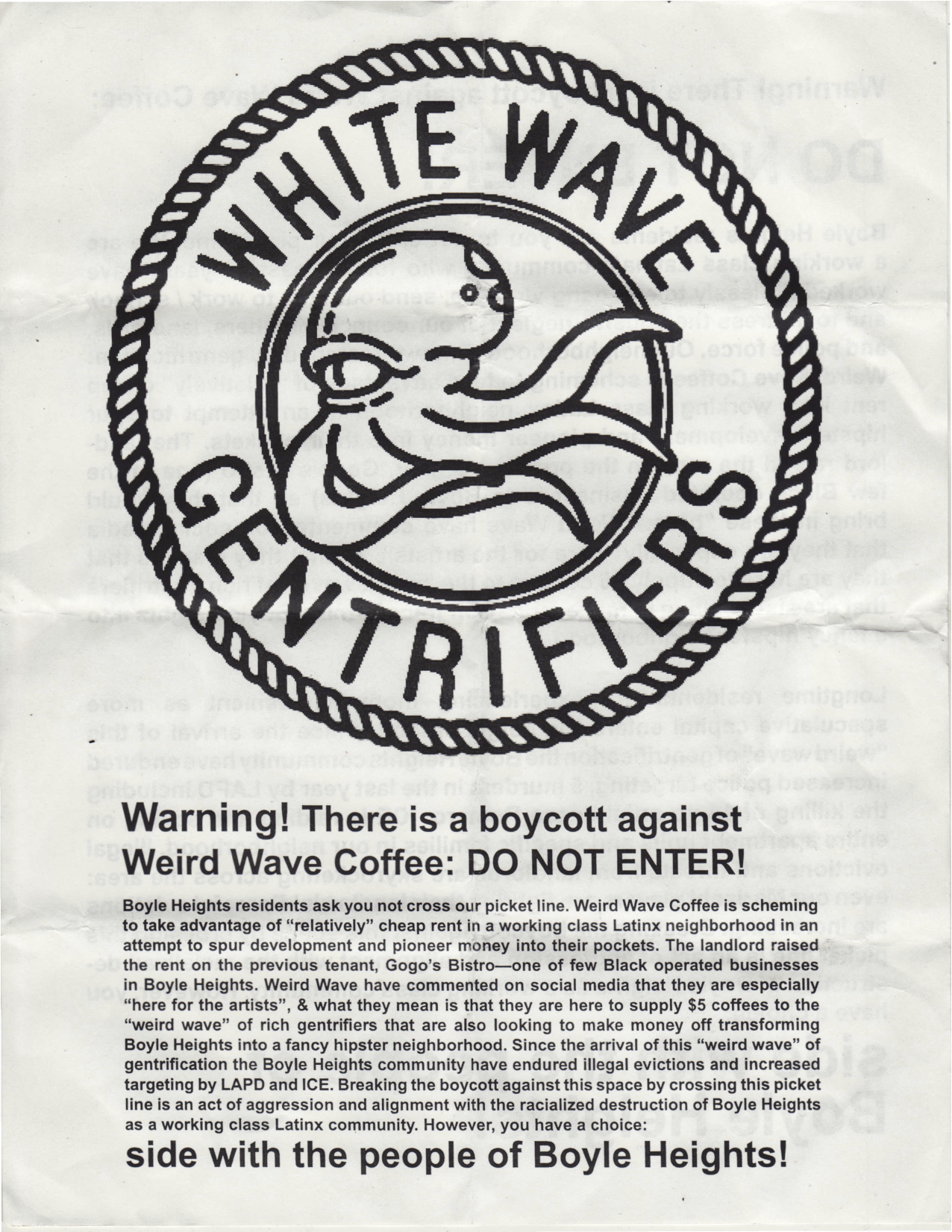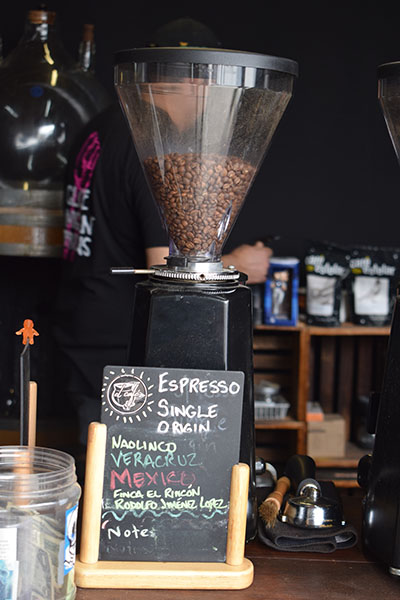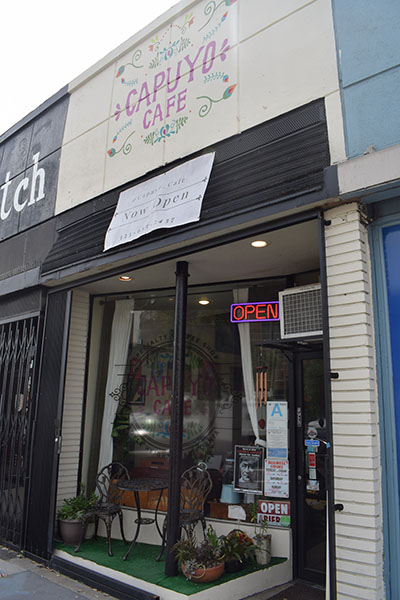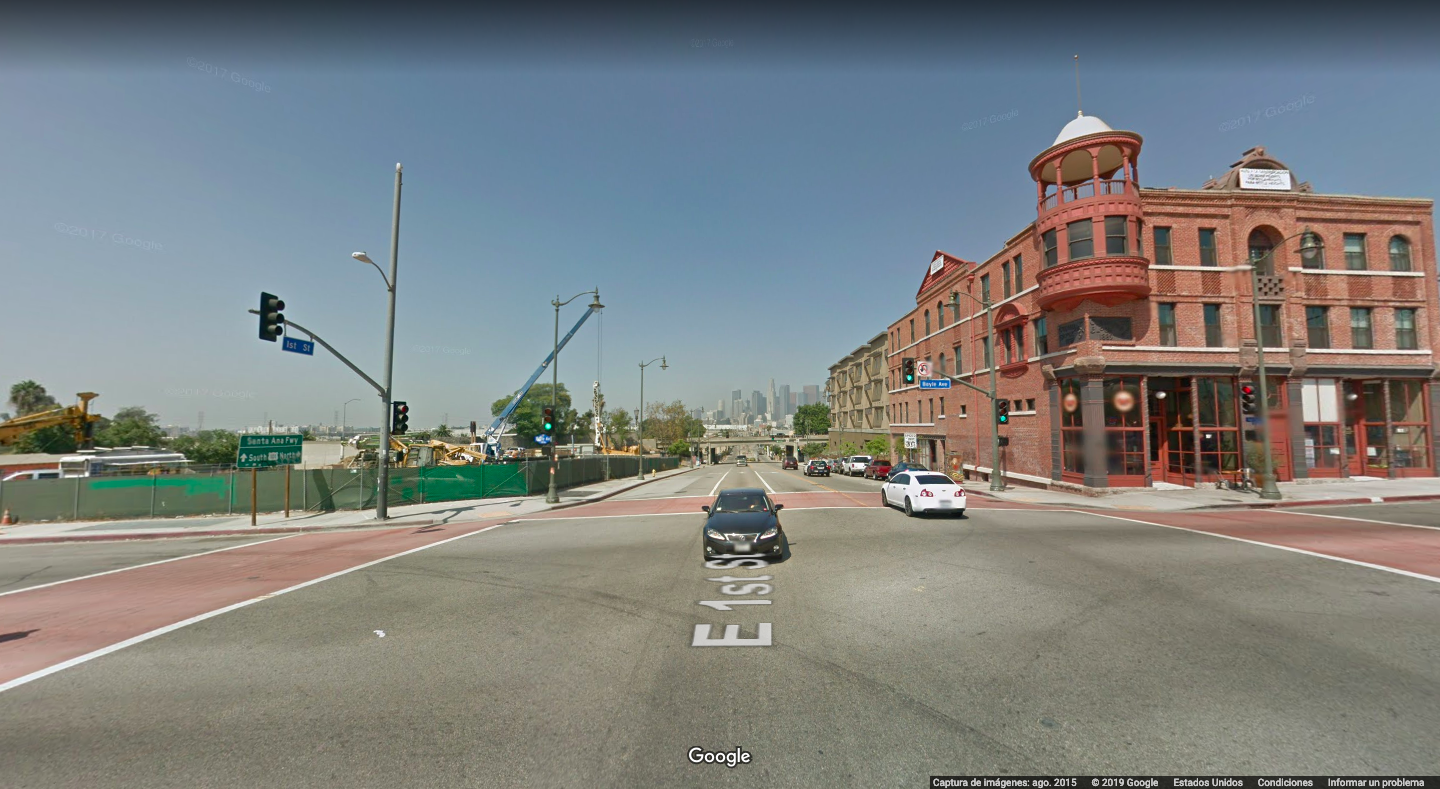By Sarah Soutoul
People broke windows. They poured motor oil in the doorway. They spray-painted things like "get out" on the building. This was the scene outside of Weird Wave Coffee, a new coffee shop that opened at the center of Boyle Heights in June 2017.
 Defend Boyle Heights flyer protesting against Weird Wave Coffee.
Umberto Brayj/Flickr/Creative Commons
Defend Boyle Heights flyer protesting against Weird Wave Coffee.
Umberto Brayj/Flickr/Creative Commons
In the months following its arrival, the coffee house became a hotspot of anti-gentrification protests and the target of various acts of vandalism from local residents and activists who feared the new business would lead to rising rents and a fading local culture.
A few blocks away, located in the Boyle Heights Arts District, and barely noticeable among art galleries and photos studios, sits El Cafe by Primera Taza, a specialty coffee shop concentrating on coffees from Mexico. Unlike Weird Wave, Primera Taza has always been welcomed by the community, even in the midst of an anti-gentrification climate.
What is the difference between the two coffee shops and their owners? Primera Taza's owner Jose Tovar grew up in the neighborhood. This is what's referred to as gentefication, a twist on gentrification and 'gente', the Spanish word for people.
Gentefication happens when college-educated, upwardly mobile Latinos invest in neighborhoods they've grown up in. For some, this movement is beneficial to the neighborhood as it maintains the cultural fabric of the community while it strengthens its economic vitality.
 Coffee machine at Primera Taza & menu featuring coffees from Mexico only.
Sarah Soutoul
Coffee machine at Primera Taza & menu featuring coffees from Mexico only.
Sarah Soutoul
Tovar is even more popular than his coffee shop. His friends and customers call him Chuy. Raised in Boyle Heights, he left the neighborhood after high school to pursue a college education, but had always planned to come back and open his own business in the area.
"It's a really homie community here," he said. "That's why I decided to open something here, something that I've been part of since I moved to Los Angeles."
For Tovar, growing up in Boyle Heights helped him connect with his mostly Mexican clientele.
"You gotta know who makes up the community, or else, you won't know how to present yourselves," Tovar said. "I've always had a really close connection with Mexico, and a lot of the community members here are from Mexican descent, so it's easy for me to talk about the particulars of a certain state or a certain region of Mexico."
Jackson Defa, the co-owner of Weird Wave Coffee, agrees business owners who grew up in Boyle Heights may have a better connection with the community. However, for him, it shouldn't prevent other entrepreneurs to open their businesses in the area.
"You know if you're Latino and you open a shop in a predominantly Latino neighborhood you're going to feel attuned to that culture naturally," he said. "However, I don't know if that's an argument to open or not open a business in the neighborhood."
The faces of Boyle Heights' coffee shop owners
Click on each profile to discover the stories behind some of Boyle Heights iconic coffee shops
Are you a Gentefier?
Gentefication in Boyle Heights is what inspired Barney Santos to create Gentefy, an incubator for Latino-owned businesses in underserved neighborhoods. His company finds young Latino entrepreneurs and helps them create successful local businesses.
For Santos, the difference between gentefication and gentrification is clear.
"In one scenario, you don't have community reinvesting in the evolution of communities," he said. "That's gentrification right? With gentefication, those people get involved in a way that can economically strengthen the community, and make it more equitable."
However, while Santos supports the emergence of Latino-owned businesses, he warns against the risk of gentefication becoming gentrification. Being Latino doesn't necessarily make you less of a "gentrifier," he said
Santos said the ethnicity of business owners shouldn't matter, only how they engage with the community.
Capuyo Cafe: Sign featuring the coffee of the day from Nicaragua, South America
"If you're not involved with policy-making, if you're not involved with committees, if you're not involved with government trying to push initiatives to kind of maintain this community, then you are a brown gentrifier," he said.
 Front store of Capuyo Cafe, which opened in July 2018.
Front store of Capuyo Cafe, which opened in July 2018.
For Daisy Chavez, a community organizer and business owner herself from Boyle Heights, gentefication comes as a response to gentrification. For her, being a gentefier is about protecting the neighborhood from outsiders, who have the reputation of displacing residents and disrespecting the long lasting culture of the neighborhood.
"We want our gente to take their spot where they belong, we want that space to be given, shared and recognized," she said.
Chavez said she prefers local business owners to be from Boyle Heights, claiming that those people have "a connection to the community and are incredibly sensitive to the community and to their needs." She refers to Capuyo Cafe, located on 1st street, as an example of a "sensitive" coffee shop.
Capuyo Cafe recently opened in Boyle Heights, and its owner, Daisy Ineguez, is one of the only Latina business owners in the neighborhood. Like Primera Taza, her shop is also featuring Latin American coffees only.
The daughter of Mexican immigrants, she always wanted to open a coffee shop reflecting her heritage.
"I wanted to continue my ancestors roots and culture," she said. "Here in Boyle Heights, we're so rich in this essence of beauty, so I wanted to keep that going."
We want our gente to take their spot where they belong, we want that space to be given, shared and recognized.
Daisy refers to her coffee shop as the "living room of Boyle Heights", where everyone gathers as a community. She supports change in her neighborhood and the opening of new businesses, as long as it comes from within.
"I think it's great when I see my fellow business owners open up next door," she said. "When I close up at 4 o'clock, I go next door and have a beer at Xela's. Or I go across the street and have tacos. It's all family here."
Unlike Ineguez, Weird Wave owners are examples of "outsiders" who "showed a lack of consciousness and awareness of where they were" when opening their business, Chavez said.
Defa, the co-owner of Weird Wave, disagrees. He said his coffee shop is "a conscious business" and brings a lot to the neighborhood. For Jackson Defa, his coffee shop is serving the community, not displacing them.
"If your position is displacement and gentrification and it's ruining a neighborhood or a culture say, fair enough those things may be true, that's not the coffee shop's fault though," he said. "The people that are doing that are developers and people who flip houses and real estate agents and buyers and sellers."
While the coffee shop received complaints from the community, Defa also said it garnered an equal amount of support from many local residents. That was not covered in the press, Defa said.
Ulisses Sanchez is one of Weird Wave's loyal customers and advocate. Born and raised in Boyle Heights, Sanchez has come to enjoy a cup of coffee in Weird Wave every day since it's opened. He calls the business a "community hub".
"The employers that they hire are locals, the big goods and some of the merchandise is done by local vendors, and we have a senior citizen who sells his products to the store here, and in essence, makes a good chunk of his daily sales that way," he said. "That's the kind of entrepreneurs we want to see in this community."
For him, protesting against a coffee shop isn't going to solve issues of gentrification in Boyle Heights.
"We had issues where people were having signs with 'fuck white coffee," he said. "But, instead of investing time pushing and creating this racial rhetoric, we should convert it in creating workshops to improve economic viability, and go after the very core part of what gentrification is: the struggle of economic equity in our communities."
A neighborhood of change
Debates over gentrification in Boyle Heights aren't new. Local residents have fought the city over urban redevelopment and displacement for decades, according to Alfredo Huante, a postdoctoral research fellow and sociologist who wrote several publications on racial formation and gentrification in Los Angeles.
For Huante, Boyle Heights has been a model of successful activism in the anti-gentrification movement, which is exactly why the area is still protected from what happened in other places in Los Angeles such as Silverlake or Highland Park.
"That activism is again historic," he said. "You have a lot of historical memories of different social movements against the redevelopment of public housing projects and the displacement of residents, and people continue to point to that history of mobilization as one of the strengths than other people, other places don't get to benefit from."
While Boyle Heights historically has been a neighborhood of change, the mobilization of the community to open local businesses is recent, and something that other gentrified areas did not get.
For Barney Santos, founder of Gentefy, what separates Boyle Heights from other gentrified neighborhoods is the people willing to invest in their community.
"In all those places that have changed over time, people weren't paying attention," he said. "You have this area that's prime, rent is cheap, and all those people from the outside opening businesses, and not enough people from the community felt compelled to say, 'wait I want to put my own stamp on this community because I'm from here'."
Gentrification or gentefication, the future of Boyle Heights remains uncertain. While gentrification does bring economic growth to an area, it can come at the cost of the heart and soul of the community.
On the other side, those promoting gentefication aim to preserve the cultural integrity of the neighborhood for those who need it most, the gente. As local resident Ulisses Sanchez says, "it's a balancing act, and a very delicate line to walk.".
For Huante, only time will tell, as Boyle Heights leaves the fate of the neighborhood to its next council member.
"It will be up to the next council member to see how to protect renters in the area," he said. "That council member is not only responsible for Boyle Heights, he's also responsible for downtown. In the past, council members' attention has been on downtown over Boyle Heights."



